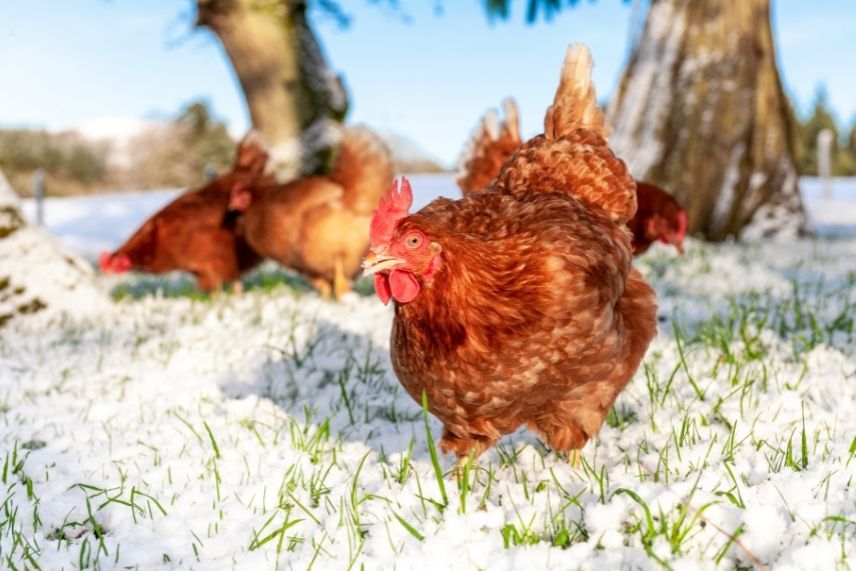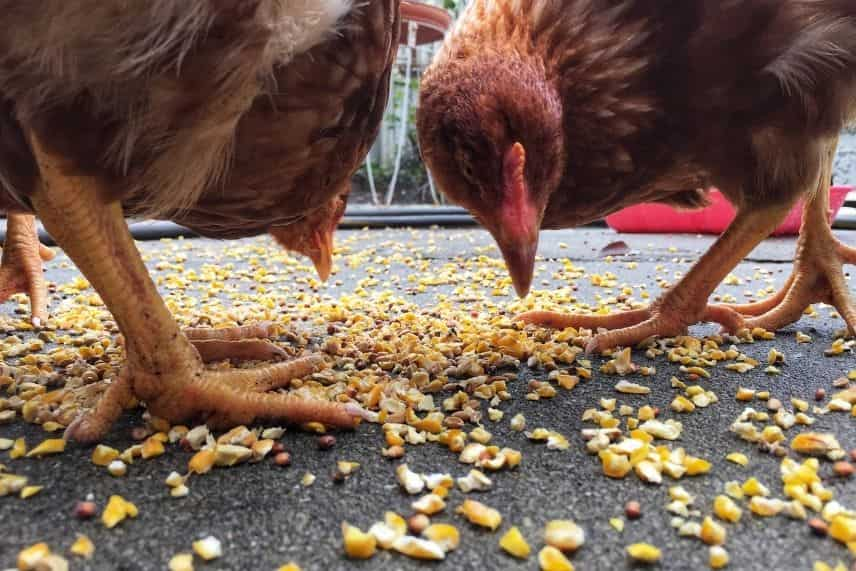
Our tips for protecting your chickens from the cold
In winter, some precautions are necessary to help your hens cope with the cold.
Contents
If you own chickens, you are understandably concerned about their well-being and health during winter. For this season not only brings cold and dampness but also reduced daylight, factors that can affect your chickens’ lives. How will they adapt to frost, the presence of snow, and the biting wind? Will they continue to lay eggs? What diet should you provide to help them through the cold season? As a happy owner of five lovely and affectionate hens living in a region where temperatures often drop to -10 to -15 °C, we offer you some tips to best protect your chickens from the winter chill.
Do hens get cold?
Having goosebumps. You know this expression that evokes the mechanism of “piloerection” related to a sensation of cold? An expression that seems to establish a link between cold and a hen. Yet, as paradoxical as it may seem, a hen does not (really) feel cold. It can indeed withstand temperatures dropping to -15 to -20 °C without truly suffering from the cold, just like the small birds in the sky that also endure the harshness of winter. Indeed, nature does things well.
To protect themselves from the cold, hens have a natural down jacket, namely their feathers. Their tight plumage traps air and forms an insulating layer; hens simply apply a thermoregulation system that maintains their body temperature at 40-42 °C. Moreover, at the end of summer or in autumn, hens over a year old molt, meaning they renew part of their feathers. All conditions are thus met to withstand the cold. However, some do not change their plumage and fare just as well. On the other hand, the legs, comb, and wattles are more sensitive to the cold. In extreme cold, these “extremities” can even freeze.

Hens do not fear the cold. Only the comb, legs, and wattles are sensitive to it.
So, while hens easily tolerate low temperatures, they are very much afraid of humidity and drafts, which can cause respiratory diseases like coryza. It is against these factors that one must primarily fight.
Similarly, if you live in a region with harsh winters, choose hardy and less sensitive breeds such as the very common Red Hen, Marans, Brahma, Wyandotte, Sussex… or hens from your region that are thus adapted to the climatic conditions.
Pascale’s advice: at my place, the Naked Neck of Forez (which is aptly named as its neck is bare!) withstands both cold and heat!
Protect the chicken coop from moisture and drafts.
Clearly, hens are not afraid of dry cold. However, there’s no question of them playing the chicken! Indeed, humidity is very harmful to them, as it creates a favourable environment for the development of respiratory diseases and other bacteria. In addition to humidity, drafts are also fatal for your hens, which may simply catch a cold or develop bronchitis. It is therefore essential to protect your henhouse from air infiltration and moisture.
Insulate and Elevate the Henhouse
If you have chosen a wooden henhouse, it is important to insulate it from the moisture of the ground. You will need to elevate it, for example by placing it on concrete blocks, wooden stilts, or on a waterproof and perfectly stable surface. Installing a ramp allows the hens to access the henhouse whenever they wish.
The second priority in extreme cold is to insulate the henhouse from the cold and especially to eliminate all sources of drafts. Without completely removing ventilation! You will need to insulate and protect your henhouse. Start with the roof, which must be completely waterproof. The simplest solution is to place a tarpaulin on the outside. As for the interior walls, they can be covered with plywood boards under which you can slide sheets of polystyrene or cork, any mineral fibre, or even bubble wrap. Be careful to hide these insulators well, as the hens will enjoy pecking at them.
A sturdy henhouse with a good door is ideal in winter to protect the hens from the cold.
However, insulating does not mean sealing it airtight! Keep doors and windows clear so they can be opened during the day to ensure good ventilation.
Spread a Good Litter Layer
To protect the hens from both cold and moisture, provide their little feet with a good litter layer of straw (or, if necessary, large wood shavings). And don’t skimp on the thickness! Aim for between 5 and 10 cm for a good, warm carpet that the hens will enjoy scratching and pecking at.

In winter, a luxury litter layer for my hens who will spend a warm night
Of course, for perfect hygiene in the henhouse, this straw litter should be cleaned regularly, as, if it snows, the hens will spend more time in the henhouse.
To Heat or Not?
In shops and on specialised websites, you can find heating lamps specifically designed for henhouses that provide a bit of warmth while also offering light, which is rarer outside. What to think of them? On one hand, they must meet all current safety standards to avoid any fire risk. Furthermore, they are to be reserved for large, sturdy henhouses. Finally, they are only useful in very cold regions, as they may destabilise the hens, causing them to lose their sense of time. Therefore, they should only be operated for a few hours a day.
Adapting Chicken Feed to Withstand the Cold
In winter, hens expend a bit more energy to combat the cold. Additionally, the insects and worms that make up their daily menu have become scarce. To help them effectively fight against the cold, it is advisable to enrich their food with proteins, minerals, and vitamins. Thus, you can add to their ration:
- dehydrated insects such as mealworms, soldier fly larvae…
- crushed corn and oats, which will help them build a layer of fat
 An intake of corn is recommended in winter
An intake of corn is recommended in winter
- beetroots or forage cabbages from the garden, harvested as needed, which provide a significant source of greenery
- Oyster shells for calcium intake (provided throughout the year, in fact!)
Pascale’s tip: when the cold sets in, I prepare a mash that my hens love. To cooked vegetable peelings, I add rice, pasta, semolina, or mashed potatoes, but also, occasionally, chickpeas, lentils, dried beans, or cooked peas for the supply of plant proteins. This mash is served warm to them in the morning to compensate for the night’s cold. However, I do not give them any meat or fish scraps. I also let them roam in the vegetable garden, empty of all crops, to enjoy pest larvae and, incidentally, earthworms, of which my soil is full.
Prevent water from freezing
At any time of year, a hen needs to drink. This is essential for its survival. However, in winter, the water in the bowls freezes easily. And hens’ beaks are not capable of breaking the ice.
If you are present, you can refresh the water or break the ice layer! But that can be tedious…
There are a few little tricks that hen owners pass on quietly:
- choose a sufficiently large container that you place out of the cold winds and, if possible, in a sunny area (if the sun is willing to grace a winter’s day with its presence!)
- prefer a plastic bowl where the water freezes less quickly than in a metal container
- float a ping-pong ball in the water which, with the slightest breath of wind, moves and slightly delays the freezing of the water
- use a heated bowl or a heating pad for the waterer. The only downside: having an electrical supply nearby.
Let your hens out to encourage laying.
Chickens love to go out whether it’s freezing, raining, or snowing. Nothing stops them, and they know how to find their way back to their coop if the weather really turns bad. When confined in the coop, they become stressed, a situation that leads to pecking and diseases.
However, it is advisable to provide them with a shelter that allows them to stay outside in all weather conditions. Whether you build it from reclaimed wood with just four wooden posts and a corrugated sheet or buy a tarpaulin, place this shelter out of the wind.

In winter, chickens appreciate an outdoor shelter with a perch to protect them from the cold
In regions where snow can fall heavily, it is also recommended to create a path for your hens to their outdoor shelter. A good shovel will do the trick, and they will be grateful!
Finally, one last precaution is necessary in case of extreme cold: apply a bit of petroleum jelly to the feet, wattles, and comb of your chickens. This greasy substance forms an insulating layer against the cold.
To conclude
With all these preventive measures, your hens should get through the winter without any issues and continue to lay despite the cold.
In fact, it’s often the extreme heat that they fear the most. The outdoor shelter will be very useful for protecting them from the scorching rays of the sun.
The little note from Pascale: as for my five hens (Zoumzoum, Tic and Tac, Boule de neige, and Rocheteau), they have just experienced their second harsh winter (the thermometer dropped to -7 to -10 °C for three weeks without interruption) with an average of 4 to 5 eggs per day!
- Subscribe!
- Contents
































Comments